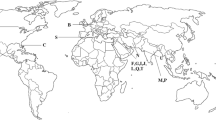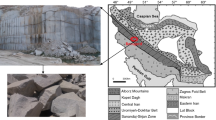Abstract
In this study, density, porosity, void ratio, and ultrasonic P- and S-wave first arrival times were measured on limestone, sandstone, and siltstone samples obtained by using mechanical soundings in the city of Zonguldak. Turkey. Fracture and fissure indexes of rocks were calculated from ultrasonic P- (Vp) and S-wave (Vs) velocities. Multi-parameter relationships occurred between ultrasonic velocities with seismic fracture and fissure indexes and physical and mechanical properties of the rocks. Root mean squared error (RMSE = 0.5–0.8%) values correlated between measured densities and densities calculated from Vp and Vs. The correlation coefficients of experimental relations between densities, void ratio, and porosity with seismic velocities that were obtained ranged from 78, 86, 67, and 84%, respectively. Consequently, natural, water-saturated and grain densities, porosity, and void ratio values were determined from new multi-parameter relationships obtained from the combined use of Vp and Vs. In addition, the results of this study suggest that the rock quality may wrongly be determined using the only Vp, whereas it can be obtained more accurately by using Vp and Vs together. The reason for this is that the P wave spreads in solid, liquid, and gas media, while the S-wave spreads only in solid media. Therefore, S-waves will not be altered by fracture filling (gas or liquid), while P-waves are affected by fracture filling. In the present study, the use of Vp and Vs together in relationships was more useful in determining the strength and hydraulic properties of rock mass that the use of either Vp or Vs alone. Also, Rock Quality Designation (RQD) and Rock Mass Rating (RMR) values can be correctly calculated from the combined use of Vp and Vs. As a result, interpretation of crack fill and classification of the rocks can be quickly performed using seismic velocities.










Similar content being viewed by others
References
Altıntaş M (1996) The relations between the seismic parameters and some of the rock mechanics parameters. Master’s thesis. Graduate School of Science, Ankara University, Ankara (in Turkish)
ASTM D7263-09 (2018) Standard Test Methods for Laboratory Determination of Density (Unit Weight) of Soil Specimens. Annual Book of ASTM Standards, Vol. 04.09
ASTM International. D 2845-00 (n.d.) (2015). Standard test method for laboratory determination of pulse velocities and ultrasonic elastic constants of rock. In: Annual book of ASTM standards vol. 14.02. ASTM International, West Conshohocken
ASTM International (2002) ASTM D2938-95 (2002). Standard test method for unconfined compressive strength of intact rock core specimens. In: Annual book of ASTM standards. ASTM International, West Conshohocken
Babacan AE, Ersoy H, Gelisli K (2012) Physical properties of rocks, and time-frequency analysis techniques to determine ultrasonic velocity, beige limestone (NE Turkey) on a case study. J Eng Geol 36(1):63–73
Bieniawski ZT (1989) Engineering rock mass classifications—a complete manual for engineers and geologists in mining civil, and petroleum engineering. Wiley, New York
Birch F (1966) Compressibility; elastic constants. In: Clark SP (ed) Handbook of physical constants. Geol Soc Am Mem 97:97–174
Brown ET (1981) Rock characterization testing and monitoring. International Society for Rock Mechanics suggested methods. Pergamon Press, Oxford
Chen X, Xu Z (2017) The ultrasonic P-wave velocity-stress relationship of rocks and its application. Bull Eng Geol Environ 76:661–669
Christensen NJ (1982) Seismic velocities. In: Carmichael RS (ed) Handbook of physical properties of rocks vol. 2. CRC Press,.Inc, Baton Rouge, pp 2–227
Deere DU, Deere DW (1988) The RQD Index in Practice. ASTM Special Technical Publication, 984:91–101
Deere DU, Miller RP (1966) Classification and index properties of intact rock. Technical report AFWL-TR-65-116. AF Special Weapons Center, Kirtland Air Force Base, New Mexico
Diethart-Jauk E, Gegenhuber N (2018) Shear weakening for different lithologies observed at different saturation stages. J Appl Geophys 148:107–114
El-Naqa A (1996) Assessment of geomechanical characterization of a rock mass using a seismic geophysical technique. Geotech Geol Eng 14:291–305
Fourmaintraux D (1976). Characterization of rocks laboratory tests. In: Panet M (ed) La Mechanique des roches applique aux ouvrages du genie civil. Ecole Nationale des Ponts et Chaussees, Paris, p 235
Gardner GHF, Gardner LW, Gregory AR (1974) Formation velocity and density- the diagnostic basic for stratigraphic traps. Geophysics 39(6):770–780
Gaviglio P (1989) Longitudinal waves propagation in a limestone: The relationship between velocity and density. Rock Mech Rock Eng 22:299–306
Goodman RE (1976) Classification and index properties of rocks: Introduction to mechanics of rock, second printing. Translated by K. Kayabali). Published by John Wiley and Sons, New York
Harrison JP, Hudson FJA (2000) Cracks and semi-spherical projection. In: Engineering rock mechanics, vol. 2: solved examples. Translated by Kamil Kayabali and Hasan Arman. Published by Elsevier Science, p 506. https://doi.org/10.1016/B978-0-08-043010-2.X5000-X
Huang X, Qi S, Guo S, Dong W (2014) Experimental study of ultrasonic waves propagating through a rock mass with a single joint and multiple parallel joints. Rock Mech Rock Eng 47:549–559
Ji S, Wang Q, Salisbury MH, Wang Y, Jia D (2017) P-wave velocities and anisotropy of typical rocks from the Yunkai Mts. (Guangdong and Guangxi, China) and constraints on the composition of the crust beneath the South China Sea. J Asian Earth Sci 141:213–234
Kahraman S, Yeken T (2008) Determination of physical properties of carbonate rocks from P-wave velocity. Bull Eng Geol Environ 67:277–281
Kahraman S, Soylemez M, Fener M (2008) Determination of fracture depth of rock blocks from P-wave velocity. Bull Eng Geol Environ 67:11–16
Karpuz C, Paşamehmetoğlu AG (1997) Field characterization of weathered Ankara Andesites. Eng Geol 46(1):1–17
Lee JS, Yoon HK (2017) Characterization of rock weathering using elastic waves: a laboratory-scale experimental study. J Appl Geophys 140:24–33
Malinaric S, Kostial P (1998) Contribution to the signal processing of ultrasonic pulses. J Phys 31(8):970–977
Nguyen ST, To QD, Vu MN (2017) Extended analytical solutions for effective elastic moduli of cracked porous media. J Appl Geophys 140:34–41
Sabbağ N, Uyanık O (2017) Prediction of reinforced concrete strength by ultrasonic velocities. J Appl Geophys 141:13–23
Sharma PK, Singh TN (2008) A correlation between P-wave velocity, impact strength index, slake durability index and uniaxial compressive strength. Bull Eng Geol Environ 67(1):17–22
Shi ZM, Liu L, Peng M, Liu CC, Tao FJ, Liu CS (2018) Non-destructive testing of full-length bonded rock bolts based on HHT signal analysis. J Appl Geophys 151:47–55
Sjøgren B, Øfsthus A, Sandberg J (1979) Seismic classification of rock mass qualities. Geophys Prospect 27:409–442
Song I, Suh M (2014) Effects of foliation and microcracks on ultrasonic anisotropy in retrograde ultramafic and metamorphic rocks at shallow depths. J Appl Geophys 109:27–35
Thanvarachorn P, Srisuk K, Tassanasorn A-O, Lertsirivorakul R (1984) Dynamic elastic properties of the Phu Phan Sandstone. In: Thiramongkol N, Nakapadungrat S, Pisutha-Arnond V (eds) Conference on Applications of Geology and the National Development. Published by Department of Geology, Chulalongkorn University, Department of Mineral Resources, Geological Society of Thailand, Bangkok, pp 157–161
Thill RE, Bur TR (1969) An automated ultrasonic pulse measurement system. Geophysics 34:101–105
Toksöz MN, Cheng CH, Timur A (1976) Velocities of seismic waves in porous rocks. Geophysics 41(4):621–645
Turk N, Dearman WR (1986) A suggested approach to rock characterization in terms of seismic velocities. In: Hartman AL (ed) 27th US Symp Rock Mechanics. Society for Mining, Metallurgy and Exploration (SME), Littleton, pp 168–175
Uyanık O (1991) Importance of geophysical laboratory parameters of rock mechanics and the associating DEU. Thesis. Geophysical Engineering Department, Izmir (in Turkish)
Uyanık O (2011) The porosity of saturated shallow sediments from seismic compressional and shear wave velocities. J Appl Geophys 73(1):16–24
Uyanık O, Çatlıoğlu B (2015) Determination of density from seismic velocities. Jeofizik 17:3–15 (in Turkish)
Wang J-H, Hung J-H, Dong J-J (2009) Seismic velocities, density, porosity, and permeability measured at a deep hole penetrating the Chelungpu fault in Central Taiwan. J Asian Earth Sci 36(2–3):135–145
Wang Y, Li X (2015) Experimental study on cracking damage characteristics of a soil and rock mixture by UPV testing. Bull Eng Geol Environ 74:775–788
Wang Z (2002) Seismic anisotropy in sedimentary rocks, part 2: laboratory data. Geophysics 67(5):1423–1440
Wilkens R, Simmons G, Caruso L (1984) The ratio Vp/vs as a discriminant of composition for siliceous limestones. Geophysics 49:1850–1860
Zhang Z, Wanga E, Chena D, Li X, Li N (2016) The observation of AE events under uniaxial compression and the quantitative relationship between the anisotropy index and the main failure plane. J Appl Geophys 134:183–190
Author information
Authors and Affiliations
Corresponding author
Appendix: Complete citations for studies reported in Fig. 3
Appendix: Complete citations for studies reported in Fig. 3
-
Altındağ R (2012) Correlation between P-wave velocity and some mechanical properties for sedimentary rocks. J South Afr Inst Min Metall 112(3):229–237.
-
Chary KB, Sarma LP, Lakshmi KJP, Vıjayakumar NA, Lakshmi VN, Rao MVMS (2006) Evaluation of engineering properties of rock using ultrasonic pulse velocity and uniaxial compressive strength. In: Rao MVMS (ed) Proc National Seminar on Non-Destructive Evaluation. Published by Indian Society for Non-Destructive Testing Hyderabad, Hyderabad, pp 379–385.
-
Christaras B, Mariolakos I, Foundoulis J, Athanasias S, Dimitriou A (1997) Geotechnical input for the protection of some Macedonian tombs in Greece. In: Moropoulou A, Zezza F, Kollias E, Papachristodoulou I (eds) Proc The 6th Int Symp Conservation of Monuments in the Mediterranean Basin. Published by Technical Chamber of Greece, Rhodes, pp 125–132.
-
Çobanoğlu I, Çelik SB (2008) Estimation of uniaxial compressive strength from point load strength, Schmidt hardness and P-wave velocity. Bull Eng Geol Environ 67:491–498.
-
Göktan RM (1988) Theoretical and practical analysis of rock rippability. PhD thesis. Istanbul Technical University, Istanbul (in Turkish).
-
Kahraman S (2001) Evaluation of simple methods for assessing the uniaxial compressive strength of rock. Int J Rock Mech Min Sci 38:981–994.
-
Kılıç A, Teymen A (2008) Determination of mechanical properties of rocks using simple methods. Bull Eng Geol Environ 67:237–244.
-
Sousa LMO, Rıo LMS, Calleja L, Argandona VGR, Rey AR (2005) Influence of microfractures and porosity on the physico-mechanical properties and weathering of ornamental granites. Eng Geol 77:153–168.
-
Tercan AE, Ünver B, Tiryaki B, Özbilgin D (2005) A study of relationships among mechanical, index and petrographic properties of some sandstones using canonical correlation analysis (in Turkish). Mining 44:3–14.
-
Tugrul A, Zarif H (1999) Correlation of mineralogical and textural characteristics with engineering properties of selected granitic rocks from Turkey. Eng Geol 51(4):303–317.
-
Vasconcelos G, Lourenço PB, Alves CAS, Pamplona J (2008) Ultrasonic evaluation of the physical and mechanical properties of granites. Ultrasonics 48:453–466.
-
Yağız S (2011) P-wave velocity test for assessment of geotechnical properties of some rock materials. Bull Mater Sci 34(4):947–953
-
Yaşar E, Erdoğan Y (2004) Correlating sound velocity with the density, compressive strength and Young’s modulus of carbonate rocks. Int J Rock Mech Min Sci 41:871.
-
Yaşar E, Erdoğan Y (2003) Yapı-kaplama kayalarının P dalga hızı ile fiziko-mekanik özellikleri arasındaki ilişkilerin istatiksel analizi, Türkiye IV. In: Ersoy M (ed) Marble Symposium (Mersem’2003). Published by TMMOB Maden Mühendisleri Odası, pp 353–362 (in Turkish).
-
Zukui L, Xinxu Z, Jinhai Z, Daixu T, Yongsong T, Jing Y, Yanqing L (2001) The experiment investigation of the correlation of acoustic logging and rock mechanical and engineering characteristics. In: Sijing W, Bingiun F, Zangkui L (eds) Frontiers of rock mechanics and sustainable development in the 21st Century. Published by CRC press, pp 89–92.
Rights and permissions
About this article
Cite this article
Uyanık, O., Sabbağ, N., Uyanık, N.A. et al. Prediction of mechanical and physical properties of some sedimentary rocks from ultrasonic velocities. Bull Eng Geol Environ 78, 6003–6016 (2019). https://doi.org/10.1007/s10064-019-01501-6
Received:
Accepted:
Published:
Issue Date:
DOI: https://doi.org/10.1007/s10064-019-01501-6




